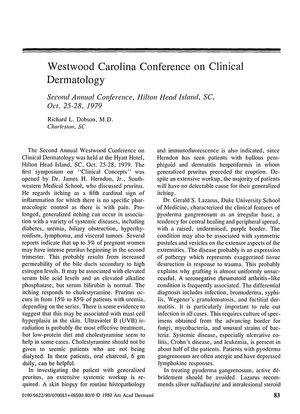Westwood Carolina Conference on Clinical Dermatology
July 1980
in “
Journal of The American Academy of Dermatology
”
hypothiotrichodystrophy iron deficiency anemia hair iron content hair growth cycle alopecia trichotillomania topical steroids methotrexate photochemotherapy PUVA oral retinoids T lymphocyte-affecting drugs iron deficiency hair loss hair cycle hair pulling disorder steroids chemotherapy light therapy psoralen and ultraviolet A retinoids immune drugs

TLDR The conference concluded that understanding hair and nail disorders is important, iron deficiency may be linked to hair loss, and while some treatments for skin conditions are effective, they may have risks and high costs.
The 1980 Westwood Carolina Conference on Clinical Dermatology presented findings on a range of dermatological conditions and their treatments, with a particular emphasis on hair and nail disorders. The conference highlighted the importance of distinguishing between different types of protein malnutrition based on hair changes, the condition of hypothiotrichodystrophy with low sulfur hair content, and the significance of examining all body hair in patients with hair loss. Dr. Wilma F. Bergfeld pointed out that low hair iron content might be associated with hair loss and iron deficiency anemia in women. The conference also discussed the normal hair growth cycle, causes of hair loss, diagnostic approaches, and the management of alopecia, including the psychological impact of trichotillomania. In terms of psoriasis treatment, topical steroids were deemed to have limited long-term benefits, while systemic chemotherapy with methotrexate was preferred. Photochemotherapy (PUVA) was effective for psoriasis and vitiligo, with a 75% improvement rate in a study of 150 patients in India, but long-term risks such as skin cancer and other damage were noted. Newer treatments, including oral retinoids and T lymphocyte-affecting drugs, were promising but faced issues with cost and toxicity. The conference suggested that future treatments might combine oral retinoids with PUVA to reduce the energy required for clearing skin conditions.